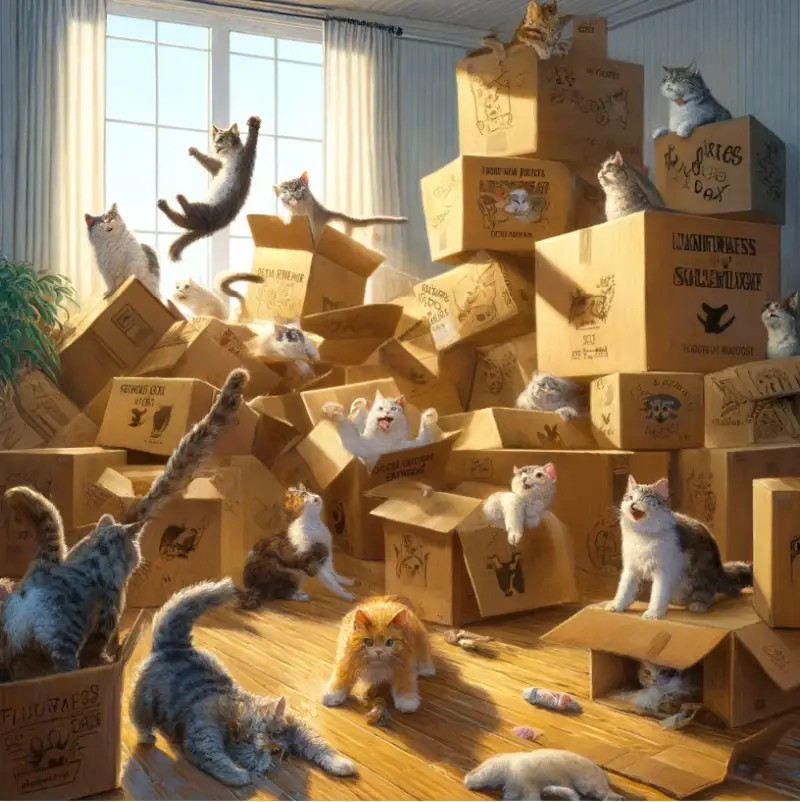
Cats and cardboard boxes seem to have an inseparable bond, one that often baffles and amuses cat owners and observers alike. This peculiar fascination is not merely a whimsical preference but is deeply rooted in the natural instincts and behavioral patterns of felines.
To understand why cats are drawn to cardboard boxes, we must delve into several scientific explanations that encompass aspects of their biology, psychology, and environmental needs.

Firstly, the attraction of cats to cardboard boxes can be attributed to their instinctual need for safety and security. In the wild, small spaces allow cats to hide from predators and stealthily observe their surroundings without being seen. A cardboard box provides a similar secluded refuge where a cat can feel protected and in control of its environment.
This need for a safe hiding spot is ingrained in their survival instincts, even for domestic cats who live in a predator-free environment. The enclosure of a box offers a sense of security and privacy, which is highly valued in the cat world where the ability to hide is synonymous with safety.

The insulation property of cardboard is another factor that contributes to its allure for cats. Cardboard has excellent insulation qualities, making boxes cozy and warm places for cats to rest. This warmth is particularly appealing, as cats have a preference for higher temperatures for relaxation and sleep.
Their thermoneutral zone, the temperature range within which they don’t have to expend extra energy to cool off or warm up, is around 86 to 97 degrees Fahrenheit (30 to 36 degrees Celsius), significantly higher than that of humans. Therefore, the warmth provided by a cardboard box can be irresistibly comfortable for a cat.

Furthermore, the texture of cardboard is appealing to cats. It provides an ideal surface for scratching, which is a natural behavior for cats. Scratching allows them to shed the outer layer of their claws, mark their territory with visual marks and scent glands in their paws, and stretch their muscles. The sound and feel of their claws digging into cardboard can be satisfying and encourage this natural behavior. Moreover, the slight give of cardboard under their claws offers a unique tactile experience that many cats find preferable to other materials.
Behaviorally, cats are also curious creatures who enjoy exploring new environments and objects. A cardboard box introduces an element of novelty and exploration. It presents an opportunity for play and investigation, stimulating their natural curiosity and hunting instincts. Cats can jump in and out of boxes, hide within them, and even use them as stalking positions, mimicking natural behaviors that would be employed during hunting in the wild. This stimulation is crucial for indoor cats, especially, as it provides mental and physical exercise, preventing boredom and promoting overall well-being.

Psychologically, the confined space of a cardboard box may also offer an environment where a cat can manage stress more effectively. According to a study published in the journal Applied Animal Behaviour Science, cats that were provided with hiding boxes experienced less stress compared to those without them. The study suggested that these boxes help in the adaptation of new cats to their environment, reducing stress levels and encouraging more exploratory behavior. The ability to retreat into a small, controlled space allows cats to escape from stressful stimuli and recover from anxiety, much like a coping mechanism.
Finally, the scent of cardboard itself may be appealing to cats. Cardboard is often made from wood pulp, which could carry natural scents that attract cats. While not as potent as catnip, the natural odors of cardboard could trigger a cat’s interest and exploration. Additionally, over time, the box absorbs the cat’s own scent, reinforcing it as a familiar and comforting territory.

Summary
The fascination of cats with cardboard boxes is a multifaceted behavior with roots in their natural instincts, biological needs, and psychological preferences. Cardboard boxes offer a unique combination of safety, comfort, and entertainment, making them irresistible to our feline friends. This behavior underscores the importance of understanding and accommodating the natural instincts and environmental needs of pets to ensure their mental and physical well-being. By providing simple pleasures like a cardboard box, cat owners can enrich their pets’ lives in meaningful ways, fostering a sense of security, comfort, and happiness in their domestic environment.
Editor’s Pick – Furhaven Multi-Level Cardboard Cat House for Indoor Cats
We like this two-level cardboard cat house that even comes with a corrugated scratching surface that has a rough, bark-like texture, and a blank interior and exterior so cats and owners can decorate the walls and space to their heart’s content. Get it here.

2 Image credits: Depositphotos



